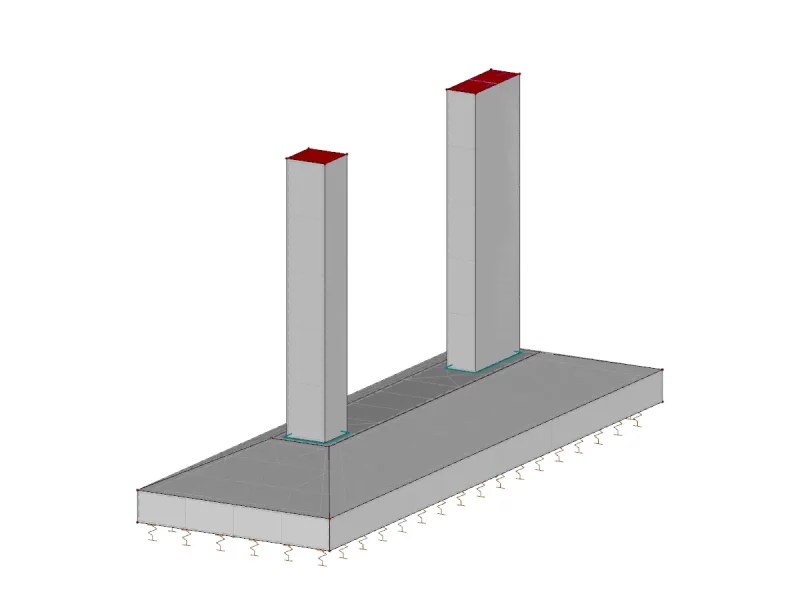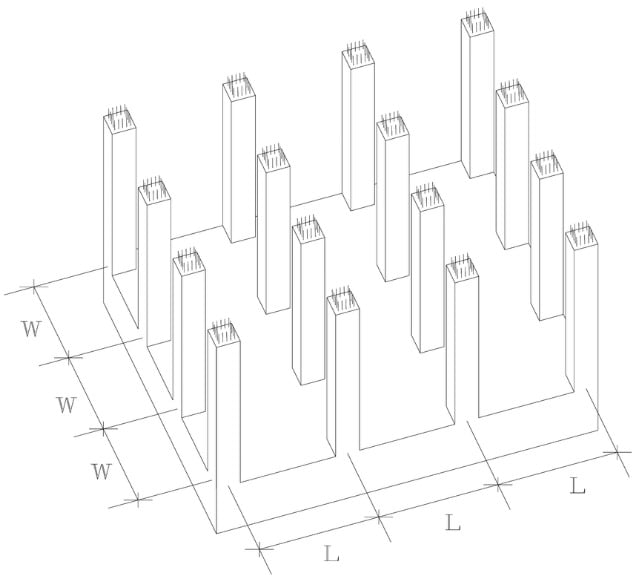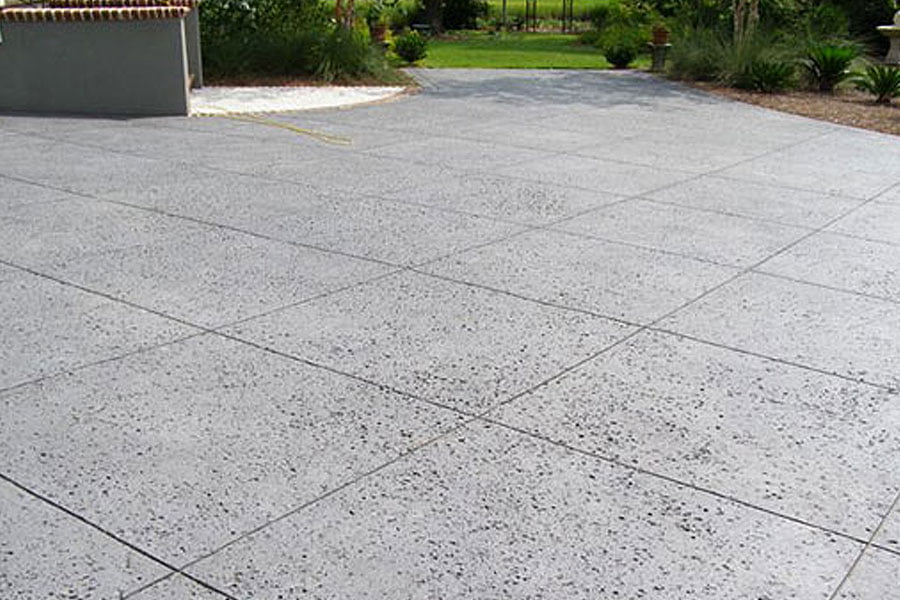Welcome to this comprehensive guide on shallow foundations. My name is Ripon C. Malo and I am a civil engineer(geotechnical) with a passion for foundation design and practice. As a geotechnical engineer, I have had the opportunity to work on numerous projects where shallow foundations were used, and I believe that it is essential for everyone to have a solid understanding of this foundation type. In this blog post, I will dive into the world of shallow foundations and explore all aspects of this widely used foundation system. From its definition to design, construction, and maintenance, we will cover everything you need to know about shallow foundations. Whether you are a civil engineer, contractor, builder, or simply interested in the topic, this guide will provide you with a comprehensive understanding of shallow foundations and their importance in the field of civil engineering. So, let’s get started!
Definition of Shallow Foundation
Shallow foundations are a kind of sub-structure that transfers loads of a structure to the soil near the surface. They are typically used when the ground has adequate strength and stiffness to support the load without excessive settlement or failure. Shallow foundations are also preferred when the groundwater table is high or when deep excavation is not feasible or economical.
According to Terzaghi’s Bearing capacity theory, a foundation is called shallow if the depth (Df) of the foundation is less than or equal to the width (B) of the foundation.
Df/B≤1

Importance of Shallow Foundations in Construction
Shallow foundations are essential in construction as they provide a stable platform for buildings, ensuring their long-term performance and safety. They are relatively cost-effective, easier to construct, and suitable for most soil types and structures, making them the preferred choice for many construction projects.
Cost-Effectiveness and Ease of Construction
Shallow foundations are often less expensive and easier to construct compared to deep foundations. The excavation process is less complicated, and there is less need for specialized machinery or equipment. This cost-effectiveness and ease of construction make shallow foundations a popular choice for smaller, lighter structures.
Suitable for Various Soil Conditions
Shallow foundations can be used in a wide range of soil conditions, making them a versatile option for different construction projects. They are particularly effective in areas with well-draining, stable soils. This adaptability ensures that shallow foundations are suitable for various construction projects.
Reduced Environmental Impact
As shallow foundations require less excavation and displacement of soil, their environmental impact is generally lower compared to deep foundations. This reduced impact is particularly important for construction projects that are located near sensitive ecosystems or require minimal disturbance to the surrounding environment.
Faster Construction Time
The construction process for shallow foundations is relatively straightforward and can be completed more quickly than that of deep foundations. This faster construction time allows projects to be completed more efficiently, reducing overall costs and ensuring timely completion.
Resistance to Differential Settlement
Differential settlement occurs when different parts of a foundation settle at varying rates, which can lead to structural damage. Shallow foundations distribute loads evenly across the soil, making them more resistant to differential settlement and helping to maintain the structural integrity of the building.
Flexibility in Design
Shallow foundations can be designed in various shapes and sizes to suit the requirements of a particular construction project. This flexibility allows engineers and architects to optimize the foundation design for the specific needs of the building, ensuring an efficient and effective support system.
Types of shallow foundation
There are various types of shallow foundations available to suit different construction projects and soil conditions. By understanding the unique characteristics and applications of each foundation type, engineers and architects can select the most appropriate option for a given project, ensuring a safe and stable structure that stands the test of time.
Footings
Footings are the most common type of shallow foundation, consisting of a widened base that spreads the load of the structure over a larger area. They are typically used for buildings with relatively light loads and good soil conditions. Footings can be further classified into the following subtypes:

a. Isolated Footings: These footings support individual columns and are typically used for low-rise buildings and residential structures.

b. Combined Footings: Combined footings are used to support multiple columns and are often employed when columns are closely spaced or near the property boundary.

c. Wall footing or Strap Footings: Strip footings are similar to spread footings, but they have a narrow width compared to their length. They are used to support continuous walls or rows of columns along a linear direction. The width and thickness of the strip footing depend on the load per unit length and the bearing capacity and settlement of the soil.

Mat Foundations
Also known as raft foundations, mat foundations are large, continuous slab that supports the entire structure, distributing loads uniformly across the soil. They are often used in situations where the soil has a low bearing capacity or when the building load is heavy and spread footings would cover more than 50% of the building area.

Grillage Foundation :
A grillage foundation is a type of shallow foundation consisting of horizontal layers of beams (usually steel or wooden) laid on a layer of concrete or compacted soil. The beams are placed in a crisscross pattern to distribute the load evenly and reduce the pressure on the underlying soil. It is commonly used for supporting heavy structures like bridges, columns, and piers.

Design Principles and Considerations of Shallow Foundation
Shallow foundations also have some limitations and challenges that need to be considered in the design process. Some of these are:
Soil Investigation and Bearing Capacity
A thorough soil investigation is crucial for determining the bearing capacity of the ground and selecting an appropriate foundation type. Soil properties, such as density, moisture content, and shear strength, influence the foundation’s performance and stability. The foundation should be designed to have a safety factor that ensures that the applied load does not exceed the bearing capacity of the soil.
Settlement and Differential Settlement
Settlement is the downward movement of the foundation due to the compression of the soil under the applied load. Settlement can cause structural damage, cracks, and unevenness in the structure. To minimize settlement, the foundation should be designed to distribute the load evenly over a large area and avoid overloading the soil. The soil properties and characteristics should also be investigated and tested before choosing the type and size of the foundation.
Frost Protection
In cold climates, frost heave can cause significant damage to shallow foundations. To prevent this, foundation designs should account for frost depth, incorporating measures such as insulation or elevating the foundation above the frost line.
Seismic Considerations
In seismically active regions, shallow foundations must be designed to withstand potential ground shaking and lateral forces. This may involve using reinforced concrete, incorporating seismic isolators, or designing the foundation to accommodate potential soil liquefaction.
Load Distribution and Transfer
A foundation must be designed to transfer the structure’s loads safely and efficiently to the underlying soil. This requires accurate load calculations, considering factors such as dead loads, live loads, wind loads, and seismic loads.
Importance of Shallow Foundations in Construction
Shallow foundations are widely used in construction for various reasons, such as:
Simplicity and economy: Shallow foundations are relatively easy and cheap to design and construct compared to deep foundations. They require less excavation, material, labor, and equipment.
Adaptability and versatility: Shallow foundations can be designed for different types of structures, such as buildings, bridges, dams, towers, etc. They can also accommodate various shapes and sizes of footings, such as square, rectangular, circular, etc.
Reliability and durability: Shallow foundations have a long history of successful performance in different soil conditions and climates. They can resist various loads and environmental factors, such as wind, temperature, moisture, etc.
Shallow Foundation Construction Techniques
Here are some common shallow foundation construction techniques:
Excavation and Site Preparation
Site preparation involves clearing vegetation, removing topsoil, and excavating to the appropriate depth. Proper excavation ensures a stable base for the foundation and minimizes potential settlement issues.
Formwork and Reinforcement
Formwork is used to shape the concrete during pouring and curing. Reinforcement, such as steel bars or mesh, is placed within the formwork to increase the foundation’s tensile strength and resistance to cracking.
Concrete Mixing and Pouring
The concrete mix should be designed to meet the specific requirements of the foundation, including strength, workability, and durability. Once mixed, the concrete is poured into the formwork, ensuring proper consolidation to avoid voids and honeycombing.
Quality Control and Inspections
Regular inspections and quality control measures are essential to ensure the integrity of the foundation. This includes monitoring the concrete mix, checking reinforcement placement, and conducting strength tests on cured concrete samples
Innovations in Shallow Foundation Design
New Materials and Technologies
Innovative materials, such as ultra-high-performance concrete and fiber-reinforced polymers, are being developed to improve the strength and durability of shallow foundations. Additionally, new construction techniques, such as vacuum-assisted consolidation, can enhance the performance of these foundations in challenging conditions.
Advanced Design Software and Tools
Advanced software tools and numerical models are available to assist engineers in designing and analyzing shallow foundations, enabling more accurate predictions of foundation performance and optimizing designs for cost and efficiency.
Sustainable Practices in Shallow Foundation Design
Material Selection and Recycling
Using environmentally friendly materials, such as recycled aggregates or cement replacements, can reduce the environmental impact of shallow foundations. Additionally, recycling construction waste reduces landfill usage and conserves natural resources.
Minimizing Environmental Impact
Minimizing site disturbance, protecting surrounding vegetation, and implementing erosion control measures can help reduce the environmental impact of foundation construction.
Energy Efficiency and Thermal Performance
Incorporating insulation into the foundation design can improve a building’s energy efficiency and thermal performance, reducing heating and cooling costs.
Common Challenges and Solutions of Shallow Foundation
Shallow foundations are commonly used in building construction to support the weight of the building and transfer it to the underlying soil. Despite their prevalence, shallow foundations can present various challenges during construction and use. Here are some of the common challenges and solutions of shallow foundation:
Poor Soil Conditions: In areas with poor soil conditions, shallow foundations may require soil improvement techniques, such as compaction, soil replacement, or the use of geosynthetics, to enhance the soil’s bearing capacity and minimize settlement.
Slope Stability: The slope stability of the soil can be a concern in areas with steep slopes or unstable soil. The foundation can be affected by slope instability, leading to foundation movement and settlement. Perfect site analysis and geological investigation can help in identifying potential slope stability issues. Proper foundation design techniques such as using retaining walls, soil stabilization, and slope reinforcement can be used to mitigate slope instability.
Differential Settlement: Differential settlement occurs when one part of the foundation settles more than the other parts, resulting in an uneven foundation. This can occur due to uneven soil conditions, construction errors, or variations in the load distribution of the building. Proper foundation design techniques such as providing uniform foundation support, increasing the foundation depth or width, and the use of reinforcing materials can help in reducing differential settlement.
Water Intrusion: Water intrusion can occur when the foundation is not adequately sealed or when the soil is too wet. This can lead to soil erosion, weakening of the foundation, and potential failure. Proper foundation waterproofing techniques such as the use of sealants, drainage systems, and proper grading can help in preventing water intrusion.
Slope Stability and Erosion Control: Shallow foundations on slopes or in areas prone to erosion require additional measures to ensure stability. This may include retaining walls, slope stabilization techniques, or erosion control measures, such as vegetation or geosynthetic reinforcement.
Frequently asked questions about shallow foundations
I explore the top frequently asked questions about shallow foundations, covering topics such as their types, uses, design considerations, and environmental factors.
What is a shallow foundation?
A shallow foundation is a type of foundation that transfers a load of a structure to the soil near the surface. It is typically used when the soil has the adequate bearing capacity and the structural loads are relatively low. Shallow foundations are less expensive and quicker to construct than deep foundations.
What are the different types of shallow foundations?
The most common types of shallow foundations are strip footings, isolated or pad footings, combined footings, raft or mat foundations, and grade beams.
When should a shallow foundation be used?
A shallow foundation should be used when the soil at the construction site has the sufficient bearing capacity and the structural loads are relatively low. They are typically used for small to medium-sized buildings, such as residential or light commercial structures.
How is the bearing capacity of soil determined for shallow foundations?
The bearing capacity of soil for shallow foundations is determined using various methods, such as Terzaghi’s bearing capacity theory, Meyerhof’s bearing capacity theory, or Hansen’s bearing capacity theory. Engineers also conduct site investigations and soil tests, like the Standard Penetration Test (SPT) and the Cone Penetration Test (CPT), to determine the soil’s properties and bearing capacity.
What factors affect the design of a shallow foundation?
The design of a shallow foundation is influenced by factors such as the soil’s bearing capacity, the type and weight of the structure, the depth of the foundation, local building codes and regulations, and potential environmental factors like frost heave, expansive soils, or seismic activity.
How deep should a shallow foundation be?
The depth of a shallow foundation depends on several factors, such as the soil’s bearing capacity, the type of structure, local building codes, and climate. Generally, shallow foundations should extend below the frost line or at least 12 inches (30 cm) into the ground.
What is a raft or mat foundation?
A raft or mat foundation is a type of shallow foundation that consists of a large, continuous slab of concrete that supports multiple columns or walls of a structure. This foundation spreads the load over a larger area, making it suitable for sites with low soil-bearing capacity or where a differential settlement needs to be minimized.
What is the difference between a shallow foundation and a deep foundation?
A shallow foundation transfers a load of a structure to the soil near the surface, while a deep foundation transfers the load to deeper layers of soil or rock. Shallow foundations are generally less expensive and quicker to construct than deep foundations but are more suitable for sites with adequate soil-bearing capacity and relatively low structural loads.
How do you prevent settlement in shallow foundations?
To prevent settlement in shallow foundations, engineers must ensure that the soil’s bearing capacity is adequate to support the structure’s weight, properly compact the soil before construction, and design the foundation to evenly distribute the load. In some cases, soil improvement techniques, such as compaction, grouting, or the use of geosynthetics, may be required to increase the soil’s bearing capacity.
What is the role of a civil engineer in designing a shallow foundation?
A civil engineer is responsible for determining the appropriate type of foundation for a project, considering factors such as the soil’s bearing capacity, the type and weight of the structure, and local building codes. They conduct site investigations and soil tests, design the foundation to safely support the structure, and oversee construction to ensure proper implementation of the design.
How do you calculate the size of a shallow foundation?
To calculate the size of a shallow foundation, engineers divide the total load (including dead loads, live loads, and any additional loads) by the allowable soil bearing capacity. This will give the required area of the foundation. The foundation dimensions are then determined based on structural requirements, construction methods, and other factors.
What is the importance of drainage in shallow foundation design?
Proper drainage is essential in shallow foundation design to prevent water buildup, which can cause soil saturation, reduce the soil’s bearing capacity, and lead to foundation settlement or failure. Engineers design effective drainage systems, including grading, drains, and waterproofing, to keep water away from the foundation and maintain the soil’s stability.
Can a shallow foundation be used for a high-rise building?
Shallow foundations are typically not suitable for high-rise buildings due to the significant loads imposed by these structures. Deep foundations, such as piles or caissons, are more appropriate for high-rise buildings, as they transfer the load to deeper, more stable soil layers or bedrock.
How do environmental factors affect shallow foundation design?
Environmental factors, such as frost heave, expansive soils, and seismic activity, can significantly impact the design and performance of a shallow foundation. Engineers must take these factors into account when designing a shallow foundation, including selecting appropriate foundation depths, materials, and reinforcement to ensure the foundation’s stability and longevity.
What is a strip footing?
A strip footing is a type of shallow foundation that supports a linear structure, such as a wall or a row of columns. The footing is a continuous strip of reinforced concrete that runs the length of the wall or column line, distributing the load to the soil below.
How does soil compaction affect shallow foundation performance?
Soil compaction is critical for the performance of a shallow foundation, as it increases the soil’s bearing capacity and reduces the potential for settlement. Properly compacted soil provides a stable base for the foundation, reducing the risk of uneven settlement or foundation failure.
How do you repair a shallow foundation?
Repairing a shallow foundation may involve underpinning, which is the process of strengthening or stabilizing the foundation by extending it to a more stable soil layer or bedrock. Other repair methods may include grouting, installing helical piers, or using chemical injections to stabilize the soil. The choice of repair method depends on the specific issues affecting the foundation and the site conditions.
What is a combined footing?
A combined footing is a type of shallow foundation that supports multiple columns or walls, distributing their loads over a larger area. This is often used when individual footings would be too close together or when the bearing capacity of the soil is low.
How does the water table affect shallow foundation design?
A high water table can impact the design and performance of a shallow foundation, as it can reduce the soil’s bearing capacity, cause buoyancy forces on the foundation, and lead to hydrostatic pressure against the foundation walls. Engineers must account for the water table when designing a shallow foundation, considering factors such as drainage systems, waterproofing, and foundation depth.
Shallow foundations are preferred when the soil has the adequate bearing capacity, as they are simpler to construct and more cost-effective compared to deep foundations. However, they are not suitable for areas with weak or compressible soils, high water tables, or when there is a need to transfer the load to a deeper, more stable soil layer. In such cases, deep foundations, like piles or caissons, may be required to ensure structural stability.
References :
Raft foundation used in the parametric study. | Download Scientific Diagram (researchgate.net)










